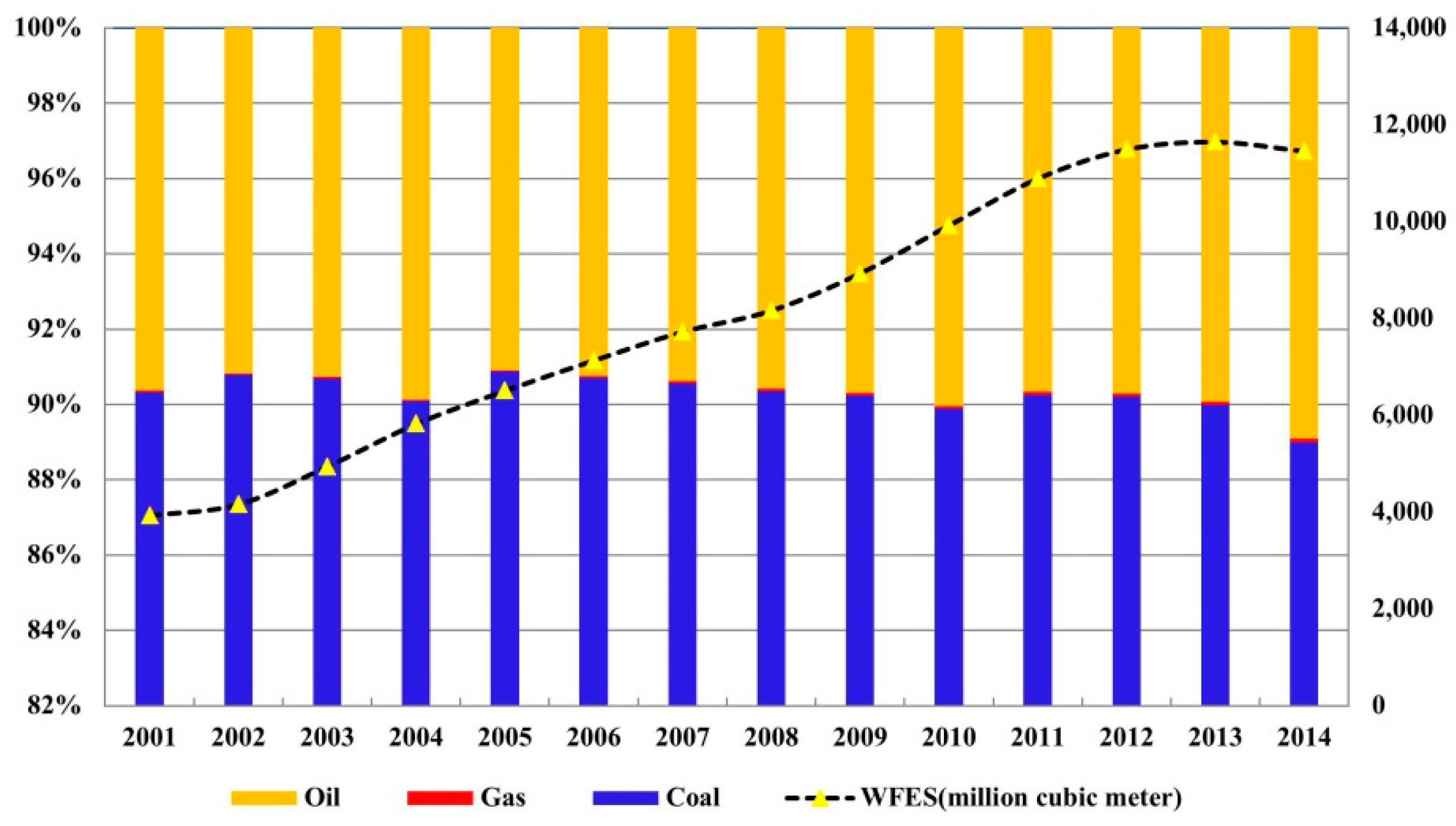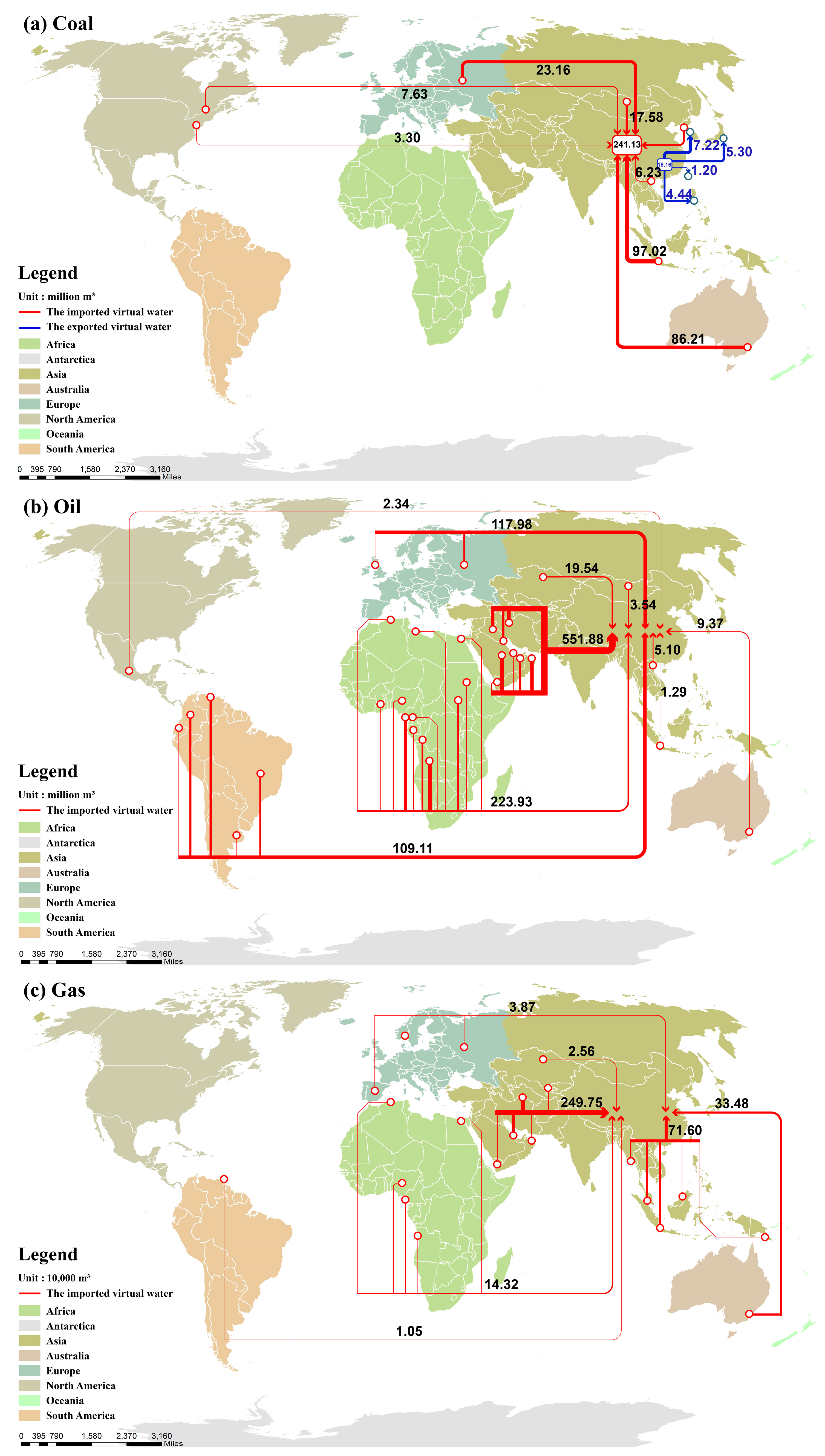Water Use of Fossil Energy Production and Supply in China
Abstract
:1. Introduction
2. Methodology
2.1. Data Acquisition
2.2. Estimation of the WFEP and WFES
2.3. Analysis of the Impact on Water Resources of Energy Production and the External Dependency Based on Water and Energy
3. Results and Analysis
3.1. Water Footprint of Fossil Energy Production in China
3.2. Water Footprint of the Fossil Energy Supply in China
3.3. Impact on Water Resources of Energy Production in China
4. Discussion
4.1. External Dependency Based on Water and Energy
4.2. Limitation of the Study
5. Conclusions
Supplementary Materials
Acknowledgments
Author Contributions
Conflicts of Interest
References
- Healy, R.W.; Alley, W.M.; Engle, M.A.; McMahon, P.B.; Bales, J.D. The Water-Energy Nexus: An Earth Science Perspective; U.S. Geological Survey: Reston, VA, USA, 2015.
- Kostecki, R.; Rao, P.; Gadgil, A. Water-Energy Nexus: The Role of Technology and Engineering. Annu. Rev. Environ. Resour. 2017, 42. [Google Scholar] [CrossRef]
- Hamiche, A.M.; Stambouli, A.B.; Flazi, S. A review of the water-energy nexus. Renew. Sustain. Energy Rev. 2016, 65, 319–331. [Google Scholar] [CrossRef]
- Huang, W.; Ma, D.; Chen, W. Connecting water and energy: Assessing the impacts of carbon and water constraints on China’s power sector. Appl. Energy 2017, 185, 1497–1505. [Google Scholar] [CrossRef]
- Zhang, C.; Anadon, L.D. Life Cycle Water Use of Energy Production and Its Environmental Impacts in China. Environ. Sci. Technol. 2013, 47, 14459–14467. [Google Scholar] [CrossRef] [PubMed]
- Tan, C.; Zhi, Q. The Energy-water Nexus: A literature Review of the Dependence of Energy on Water. Energy Procedia 2016, 88, 277–284. [Google Scholar] [CrossRef]
- Hightower, M.; Pierce, S.A. The energy challenge. Nature 2008, 452, 285–286. [Google Scholar] [CrossRef] [PubMed]
- Zhou, Y.; Li, H.; Wang, K.; Bi, J. China’s energy-water nexus: Spillover effects of energy and water policy. Glob. Environ. Chang. 2016, 40, 92–100. [Google Scholar] [CrossRef]
- Keairns, D.; Darton, R.; Irabien, A. The energy-water-food nexus. Annu. Rev. Chem. Biomol. Eng. 2016, 7, 239–262. [Google Scholar] [CrossRef] [PubMed]
- Gulati, M. The energy and water nexus: The case for an integrated approach for the green economy in South Africa. In Earth, Wind and Fire; Research and Policy Development to Advance a Green Economy in South Africa: Johannesburg, South Africa, 2016; pp. 141–160. [Google Scholar]
- Global Water Partnership (GWP). China’s Water Resources Management Challenge: The ‘Three Red Lines’; Elanders: Stockholm, Sweden, 2015. [Google Scholar]
- Guan, D.; Hubacek, K. Assessment of regional trade and virtual water flows in China. Ecol. Econ. 2007, 61, 159–170. [Google Scholar] [CrossRef]
- Wang, L.; Patel, P.L.; Yu, S.; Liu, B.; McLeod, J.; Clarke, L.E.; Chen, W. Win–Win strategies to promote air pollutant control policies and non-fossil energy target regulation in China. Appl. Energy 2016, 163, 244–253. [Google Scholar] [CrossRef]
- Lewis, J.I.; Fridley, D.G.; Price, L.K.; Lu, H.; Romankiewicz, J.P. Understanding China’s non–fossil energy targets. Science 2015, 350, 1034–1036. [Google Scholar] [CrossRef] [PubMed]
- Ratnavathi, C.V.; Chakravarthy, S.K.; Komala, V.V.; Chavan, U.D.; Patil, J.V. Sweet Sorghum as Feedstock for Biofuel Production: A Review. Sugar Tech. 2011, 13, 399–407. [Google Scholar] [CrossRef]
- National Bureau of Statistics of China (NBS). China Energy Statistical Yearbook 2015; China Statistics Press: Beijing, China, 2015. [Google Scholar]
- Brødsgaard, K.E. China’s 13th Five-Year Plan: A Draft Proposal. Cph. J. Asian Stud. 2016, 33, 97–105. [Google Scholar]
- Willaarts, B.; Lechon, Y.; de la Rúa, C.; Garrido, A. Adopting a Water-Food-Energy nexus approach to explore the synergies and trade-offs of food-water policies in Spain. EGU Gen. Assem. Conf. Abstr. 2016, 18, 9754. [Google Scholar]
- Byers, E.A.; Hall, J.W.; Amezaga, J.M. Electricity generation and cooling water use: UK pathways to 2050. Glob. Environ. Chang. 2014, 25, 16–30. [Google Scholar] [CrossRef]
- DeNooyer, T.A.; Peschel, J.M.; Zhang, Z.; Stillwell, A.S. Integrating water resources and power generation: The energy–water nexus in Illinois. Appl. Energy 2016, 162, 363–371. [Google Scholar] [CrossRef]
- Siddiqi, A.; Anadon, L.D. The water–energy nexus in Middle East and North Africa. Energy Policy 2011, 39, 4529–4540. [Google Scholar] [CrossRef]
- Pan, L.; Liu, P.; Ma, L.; Li, Z. A supply chain based assessment of water issues in the coal industry in China. Energy Policy 2012, 48, 93–102. [Google Scholar] [CrossRef]
- Zhang, C.; Zhong, L.; Fu, X.; Wang, J.; Wu, Z. Revealing Water Stress by the Thermal Power Industry in China Based on a High Spatial Resolution Water Withdrawal and Consumption Inventory. Environ. Sci. Technol. 2016, 50, 1642–1652. [Google Scholar] [CrossRef] [PubMed]
- Qin, Y.; Curmi, E.; Kopec, G.M.; Allwood, J.M.; Richards, K.S. China’s energy-water nexus—Assessment of the energy sector’s compliance with the “3 Red Lines” industrial water policy. Energy Policy 2015, 82, 131–143. [Google Scholar] [CrossRef]
- Hoekstra, A.Y.; Chapagain, A.K.; Aldaya, M.M.; Mekonnen, M.M. The Water Footprint Assessment Manual. Setting the Global Standard. Soc. Environ. Account. J. 2011, 31, 181–182. [Google Scholar]
- Duan, C.; Chen, B. Virtual Water Embodied in International Energy Trade of China. Energy Procedia 2016, 88, 94–99. [Google Scholar] [CrossRef]
- Miglietta, P.P.; De Leo, F.; Pizzi, S. The Water Footprint of Energy Crops for the Support of Italian Biodisel Production. In Proceedings of the XXVII Congresso Nazionale di Scienze Merceologiche-Qualità & Innovazione per una Economia Circolare ed un Futuro Sostenibile, Viterbo, Italy, 2–4 March 2016. [Google Scholar]
- NBS. China Energy Statistical Yearbook 2010; China Statistics Press: Beijing, China, 2010. [Google Scholar]
- IEA. International Energy Agency (IEA) Databases. Available online: http://www.iea.org/statistics/ (accessed on 10 January 2017).
- Ministry of Water Resources (MWR). Official Reports on Water Resources 2001–2015; Ministry of Water Resources: Beijing, China, 2015.
- Mulder, K.; Hagens, N.; Fisher, B. Burning water: A comparative analysis of the energy return on water invested. Ambio J. Hum. Environ. 2010, 39, 30–39. [Google Scholar] [CrossRef]
- Gheewala, S.H.; Silalertruksa, T.; Nilsalab, P.; Mungkung, R.; Perret, S.R.; Chaiyawannakarn, N. Implications of the biofuels policy mandate in Thailand on water: The case of bioethanol. Bioresour. Technol. 2013, 150, 457–465. [Google Scholar] [CrossRef] [PubMed]
- Spang, E.S.; Moomaw, W.R.; Gallagher, K.S.; Kirshen, P.H.; Marks, D.H. The water consumption of energy production: An international comparison. Environ. Res. Lett. 2014, 9, 105002. [Google Scholar] [CrossRef]
- Williams, E.; Simmons, J.E. Water in the Energy Industry: An Introduction; BP International Ltd.: Sunbury-on-Thames, UK, 2013. [Google Scholar]
- Tsinghua-BP Clean Energy Centre. Water Issues in the Coal Supply Chain in China; ESC Project Report; Tsinghua University: Beijing, China, 2011. [Google Scholar]
- Okadera, T.; Chontanawat, J.; Gheewala, S.H. Water footprint for energy production and supply in Thailand. Energy 2014, 77, 49–56. [Google Scholar] [CrossRef]
- Miller, R.E.; Blair, P.D. Input-Output Analysis: Foundations and Extensions; Cambridge University Press: Cambridge, UK, 2009. [Google Scholar]
- Okadera, T.; Watanabe, M.; Xu, K. Analysis of Water Demand and Water Pollutant Discharge Using A Regional Input–Output Table: An Application to the City of Chongqing, Upstream of the Three Gorges Dam in China. Ecol. Econ. 2006, 58, 221–237. [Google Scholar] [CrossRef]
- Zhang, Z.; Shi, M.; Yang, H.; Chapagain, A. An Input–output Analysis of Trends in Virtual Water Trade and the Impact on Water Resources and Uses in China. Econ. Syst. Res. 2011, 23, 431–446. [Google Scholar] [CrossRef]
- Okadera, T.; Geng, Y.; Fujita, T.; Dong, H.; Liu, Z.; Yoshida, N.; Kanazawa, T. Evaluating the Water Footprint of the Energy Supply of Liaoning Province, China: A Regional Input–output Analysis Approach. Energy Policy 2015, 78, 148–157. [Google Scholar] [CrossRef]
- Rui, Q.I.; Geng, Y.; Zhu, Q.H. Evaluation of Regional Water Resources Utilization Based on Water Footprint Method (in Chinese with English abstract). J. Nat. Resour. 2011, 26, 486–495. [Google Scholar]
- Tian, C. China’s 2015 oil import and exports International Petroleum Economics (in Chinese with English abstract). Int. Pet. Econ. 2016, 24, 44–53. [Google Scholar]
- United Nations World Water Assessment Programme (WWAP). The United Nations World Water Development Report 2015: Water for a Sustainable World; United Nations Educational, Scientific and Cultural Organizations: Paris, France, 2016. [Google Scholar]
- Yang, M.; Yang, L.; Hu, Z. Pattern Evolution and Challenges of Trades between China and Indo-China Peninsula Countries under the Background of “One Belt and One Road” (in Chinese with English abstract). Trop. Geogr. 2015, 35, 655–663. [Google Scholar]
- Toma, P.; Massari, S.; Miglietta, P.P. Natural resource use efficiency and economic productivity. In Life Cycle Approaches to Sustainable Regional Development; Massari, S., Sonnemann, G., Balkau, F., Eds.; Routledge-Taylor and Francis Group: Abingdon-on-Thames, UK, 2016; pp. 143–148. [Google Scholar]
- Miglietta, P.P.; Toma, P.; Fanizzi, F.P.; De Donno, A.; Coluccia, B.; Migoni, D.; Bagordo, F.; Serio, F. A Grey Water Footprint Assessment of Groundwater Chemical Pollution: Case Study in Salento (Southern Italy). Sustainability 2017, 9, 799–808. [Google Scholar] [CrossRef]





| Fossil Energy | WCF | References |
|---|---|---|
| Surface coal mining (m3 per tonne) a | 0.936 | Tsinghua-BP Clean Energy Centre [35] |
| Underground coal mining (m3 per tonne) a | 2.652 | Tsinghua-BP Clean Energy Centre [35] |
| Coal established (m3/GJ) | 0.043 | Spang et al. [33] |
| Crude oil offshore (barrels of water per barrel of oil) b | 0.0 | Williams and Simmons [34] |
| Crude oil onshore (barrels of water per barrel of oil) | 1.0 | Williams and Simmons [34] |
| Crude oil established (m3/GJ) c | 0.081 | Spang et al. [33] |
| Gas (m3/TJ) | 1.6 | Williams and Simmons [34] |
| Planning Period | Sustainability | |||
|---|---|---|---|---|
| 10th Five Year Plan | 0.012 | 0.589 | 49.641 | unsustainable |
| 11th Five Year Plan | 0.069 | 0.441 | 6.389 | unsustainable |
| 12th Five Year Plan | 0.012 | 0.128 | 10.584 | unsustainable |
| 13th Five Year Plan | 0.099 | 0.006 | 0.059 | sustainable |
© 2017 by the authors. Licensee MDPI, Basel, Switzerland. This article is an open access article distributed under the terms and conditions of the Creative Commons Attribution (CC BY) license (http://creativecommons.org/licenses/by/4.0/).
Share and Cite
Lin, G.; Jiang, D.; Duan, R.; Fu, J.; Hao, M. Water Use of Fossil Energy Production and Supply in China. Water 2017, 9, 513. https://doi.org/10.3390/w9070513
Lin G, Jiang D, Duan R, Fu J, Hao M. Water Use of Fossil Energy Production and Supply in China. Water. 2017; 9(7):513. https://doi.org/10.3390/w9070513
Chicago/Turabian StyleLin, Gang, Dong Jiang, Rui Duan, Jingying Fu, and Mengmeng Hao. 2017. "Water Use of Fossil Energy Production and Supply in China" Water 9, no. 7: 513. https://doi.org/10.3390/w9070513





